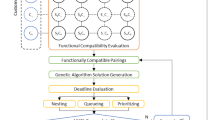Abstract
This paper presents a prototype system of sheet metal processing machinery which collects production order data, passes current information to cloud based centralized job scheduling for setup time reduction and updates the production calendar accordingly. A centralized cloud service can collect and analyse production order data for machines and suggest optimized schedules. This paper explores the application of sequencing algorithms in the sheet metal forming industry, which faces sequence-dependent changeover times on single machine systems. We analyse the effectiveness of using such algorithms in the reduction of total setup times. We describe alternative models: Clustering, Nearest Neighbourhood and Travelling Salesman Problem, and then apply them to real data obtained from a manufacturing company, as well as to randomly generated data sets. Based on the prototype implementation clustering algorithm was proposed for actual implementation. Sequence-dependency increases the complexity of the scheduling problems; thus, effective approaches are required to solve them. The algorithms proposed in this paper provide efficient solutions to these types of sequencing problems.







Similar content being viewed by others
References
Adriaans, P., & Zantinge, D. (1996). Data mining. Harlow. England: Addison-Wesley.
Bowers, M. R., Groom, K., Ng, W. M., & Zhang, G. (1995). Cluster analysis to minimize sequence dependent changeover times. Mathematical and Computer Modelling, 21(11), 89–95.
Burtseva, L., Parra, R. R., & Yaurima, V. (2010). Scheduling methods for hybrid flow shops with setup times. Rijeka: INTECH Open Access Publisher.
Cheung, W., & Zhou, H. (2001). Using genetic algorithms and heuristics for job shop scheduling with sequence-dependent setup times. Annals of Operations Research, 107(1–4), 65–81.
Dubey, R., Gunasekaran, A., Childe, S. J., Wamba, S. F., & Papadopoulos, T. (2016). The impact of big data on world-class sustainable manufacturing. The International Journal of Advanced Manufacturing Technology, 84(1–4), 631–645.
Gawroński, T. (2012). Optimization of setup times in the furniture industry. Annals of Operations Research, 201(1), 169–182.
Giglio, D. (2015). Optimal control strategies for single-machine family scheduling with sequence-dependent batch setup and controllable processing times. Journal of Scheduling, 18(5), 525–543.
Gupta, Sushil K. (1982). N jobs and m machines job-shop problems with sequence-dependent set-up times. The International Journal of Production Research, 20(5), 643–656.
Hwang, H., & Sun, J. U. (1998). Production sequencing problem with re-entrant work flows and sequence dependent setup times. International Journal of Production Research, 36(9), 2435–2450.
Kalayci, C. B., Polat, O., & Gupta, S. M. (2014). A hybrid genetic algorithm for sequence-dependent disassembly line balancing problem. Annals of Operations Research, 1–34.
Lee, J., Kao, H. A., & Yang, S. (2014). Service innovation and smart analytics for industry 4.0 and big data environment. Procedia CIRP, 16, 3–8.
Lee, J., Lapira, E., Bagheri, B., & Kao, H. A. (2013). Recent advances and trends in predictive manufacturing systems in big data environment. Manufacturing Letters, 1(1), 38–41.
Liu, Z., Wang, Y., Cai, L., Cheng, Q., & Zhang, H. (2016). Design and manufacturing model of customized hydrostatic bearing system based on cloud and big data technology. The International Journal of Advanced Manufacturing Technology, 84(1–4), 261–273.
Lockett, A. G., & Muhlemann, A. P. (1972). Technical note–a scheduling problem involving sequence dependent changeover times. Operations Research, 20(4), 895–902.
McAfee, A., Brynjolfsson, E., Davenport, T. H., Patil, D. J., & Barton, D. (2012). Big data. The Management Revolution. Harvard Business Review, 90(10), 61–67.
Mirabi, M. (2011). Ant colony optimization technique for the sequence-dependent flowshop scheduling problem. The International Journal of Advanced Manufacturing Technology, 55(1–4), 317–326.
Nonaka, Y., Erdős, G., Tamás, K., Nakano, T., & Váncza, J. (2012). Scheduling with alternative routings in CNC workshops. CIRP Annals-Manufacturing Technology, 61(1), 449–454.
Papadimitriou, Christos H. (1977). The Euclidean travelling salesman problem is NP-complete. Theoretical Computer Science, 4(3), 237–244.
Pinedo, Michael L. (2008). Scheduling: Theory, algorithms, and systems. New Jersey: Prentice-Hall.
Porter, M. E., & Heppelmann, J. E. (2014). How smart, connected products are transforming competition. Harvard Business Review, 92(11), 64–88.
Rao, Y., Huang, G., Li, P., Shao, X., & Daoyuan, Y. (2007). An integrated manufacturing information system for mass sheet metal cutting. The International Journal of Advanced Manufacturing Technology, 33(5–6), 436–448.
Reza Hejazi*, S., & Saghafian, S. (2005). Flowshop–scheduling problems with makespan criterion: A review. International Journal of Production Research, 43(14), 2895–2929.
Rudek, R. (2012). Scheduling problems with position dependent job processing times: Computational complexity results. Annals of Operations Research, 196(1), 491–516.
Spence, Anne M., & Porteus, Evan L. (1987). Setup reduction and increased effective capacity. Management Science, 33(10), 1291–1301.
Tao, F., Zhang, L., Nee, A. Y. C., & Pickl, S. W. (2016). Editorial for the special issue on big data and cloud technology for manufacturing. The International Journal of Advanced Manufacturing Technology, 84(1–4), 1–3.
von Luxburg, U., Bubeck, S., Jegelka, S., & Kaufmann, M. (1981). Nearest neighbor clustering. Annals of Statistics, 9(1), 135–140.
Westphal, S., & Noparlik, K. (2014). A 5.875-approximation for the traveling tournament problem. Annals of Operations Research, 218(1), 347–360.
White, Charles H., & Wilson, Richard C. (1977). Sequence dependent set-up times and job sequencing. The International Journal of Production Research, 15(2), 191–202.
Witten, Ian H., & Frank, Eibe. (2005). Data mining: Practical machine learning tools and techniques. Burlington: Morgan Kaufmann.
Zandin, K. B. (Ed.). (2001). Maynard’s industrial engineering handbook. New York: McGraw-Hill.
Zhong, R. Y., Lan, S., Xu, C., Dai, Q., & Huang, G. Q. (2016). Visualization of RFID-enabled shopfloor logistics Big Data in Cloud Manufacturing. The International Journal of Advanced Manufacturing Technology, 84(1–4), 5–16.
Author information
Authors and Affiliations
Corresponding author
Rights and permissions
About this article
Cite this article
Ahmadov, Y., Helo, P. A cloud based job sequencing with sequence-dependent setup for sheet metal manufacturing. Ann Oper Res 270, 5–24 (2018). https://doi.org/10.1007/s10479-016-2304-3
Published:
Issue Date:
DOI: https://doi.org/10.1007/s10479-016-2304-3




